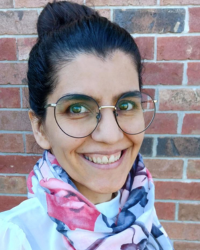Location: DC 1302
Session 1 Chair: Glen McGee, University of Waterloo
10:15 am - 10:45 am:
Dynamic Treatment Regimes and within dyad interference: A joint optimization approach
 Speaker: Marzieh Mussavi Rizi, University of Waterloo
Speaker: Marzieh Mussavi Rizi, University of Waterloo
Abstract: Precision medicine is a paradigm which prioritizes tailoring patient treatments according to their relevant traits. Within this framework, dynamic treatment regimes (DTRs) are sequences of decision rules that take individual patient information and provide treatment recommendations as output. Typically, this relies on a no-interference assumption that individuals' treatments do not impact others' outcomes. However, this assumption might not hold in practice, such as in the treatment of infectious diseases. In this talk, I will address the issues that arise when the presence of interference is disregarded and elaborate on our proposed solution to incorporate interference within a dyadic-network population setting. Our approach involves extending the DTR estimation method of dynamic weighted ordinary least squares to our specific context. I will also demonstrate the performance of our proposed method through simulation and analysis of the population assessment health data PATH study under binary and continuous treatment.
10:45 am - 11:15 am:
Using Joint Models for Longitudinal and Time-to-Event Data to Investigate the Causal Effect of Salvage Therapy after Prostatectomy
 Speaker: Jeremy M. G. Taylor, Department of Biostatistics, University of Michigan
Speaker: Jeremy M. G. Taylor, Department of Biostatistics, University of Michigan
Abstract: Prostate cancer patients who undergo prostatectomy are closely monitored for recurrence and metastasis using routine prostate-specific antigen (PSA) measurements. When PSA levels rise, salvage therapies are recommended in order to decrease the risk of metastasis. However, due to the side effects of these therapies and to avoid over-treatment, it is important to understand for which patients and when to initiate these salvage therapies. In this work, we use the University of Michigan Prostatectomy registry Data to tackle this question. Due to the observational nature of this data, we face the challenge that PSA is simultaneously a time-varying confounder and an intermediate variable for salvage therapy. We define different causal salvage therapy effects defined conditionally on different specifications of the longitudinal PSA history. Specifically, for each patient, at each time they could receive salvage therapy, we define the causal effect for that patient as the difference in the probability of developing metastases within 2 years if they were to receive salvage therapy compared to not receiving salvage therapy. These effects are averaged over appropriate subsets of the patients to a marginal causal effect of salvage therapy. We then illustrate how these effects can be estimated using a Bayesian approach within the framework of joint models for longitudinal and time-to-event data.
Contributing researchers: Jeremy M G Taylor, Department of Biostatistics, University of Michigan; Dimitris Rizopoulos, Department of Biostatistics, Erasmus University Medical Center; Grigorios Papageorgiou, Department of Biostatistics, Erasmus University Medical Center
11:15 am - 11:45 am
Acknowledging assessment times that are not at random may improve prognostic models
 Speaker: Eleanor Pullenayegum, Senior Scientist, Child Health Evaluative Sciences, U Toronto, Hospital for Sick Children
Speaker: Eleanor Pullenayegum, Senior Scientist, Child Health Evaluative Sciences, U Toronto, Hospital for Sick Children
Abstract: When analysing longitudinal data with irregular assessment times, assessment not at random occurs when having an outcome assessed at time t is dependent on the value of that outcome at time t, even after conditioning on the observed history. We tend to think of this as a bad thing, on the grounds that we believe it will make inference difficult.
Using a prospective cohort of patients with juvenile dermatomyositis for whom all follow-up occurred as part of usual care, I will argue that modelling assessment not at random can lead to valuable insights. Juvenile dermatomyositis is a chronic disease that features flares, in which previously well controlled disease worsens. Flares need to be treated and so trigger visits; this induces assessment not at random. Being able to quantify the frequency and severity of flares is important information for patients and their families; statistical models typically ignore the presence of flares.
I will propose a model that incorporates flares and maintains identifiability throughg physician-informed priors. This model includes parameters for the frequency of flares, the severity of flares, and the disease trajectory in the absence of flares, all of which are useful prognostic information. Future work will examine whether patient-level information can be used to predict flare frequency. This model may be useful for other diseases that feature a relapsing-remitting course, such as lupus or multiple sclerosis. A particular area of interest is to examine whether it can be used to study genetic predictors of flare frequency in lupus.
11:45 am - 12:15 pm
Individual-level models of disease transmission: a tool for precision health?
 Speaker: Rob Deardon, Professor (Biostatistics), University of Calgary
Speaker: Rob Deardon, Professor (Biostatistics), University of Calgary
Abstract: Over the past few years, there has been an understandable increase in interest in epidemic models. However, the nature of the COVID pandemic, and data available, has meant most of this focus has been on so-called population-level models.
However, there are often complex heterogeneities in the population which we wish to account for, since, for example, populations do not tend to mix homogeneously. Sometimes, we may wish to account for such heterogeneities using spatial mechanisms that assume that transmission events are more likely to occur between individuals close together in space than individuals further apart. Sometimes, it is more natural to model such heterogeneities using contact networks that represent, for example, social, domestic or sexual relationships. We may also want to include individual-level covariates associated with the risk of contracting and/or passing on the disease, such as vaccination status or age.
Individual-level models allow us to account for such complex systems. Typically, statistical inference for these models (e.g., parameter estimation) is done in a Bayesian context using computational techniques such as Markov chain Monte Carlo (MCMC). This is in part due to the non-standard form of the models, but also in part due to the fact that we often have missing or uncertain data; for example, infection times are rarely observed. Bayesian data augmentation provides a natural framework for allowing for such uncertainty.
Here we examine the main characteristics of such infectious disease models, and discuss their potential as a tool for use in precision health.
About the Speakers
 Marzieh Mussavi Rizi, University of Waterloo
Marzieh Mussavi Rizi, University of Waterloo
Marzieh Mussavi Rizi is a biostatistics PhD candidate at the University of Waterloo under the joint supervision of Professors Joel Dubin and Michael Wallace. Her current research focuses on dynamic treatment regimes and their application in personalized medicine. She is interested in extending the methods developed to machine learning, specifically reinforcing learning and large language models in personalized medicine.
__
 Jeremy Taylor, University of Michigan
Jeremy Taylor, University of Michigan
Professor, Department of Radiation Oncology and Department of Computational Medicine and Bioinformatics
Profile Link: https://sph.umich.edu/faculty-profiles/taylor-jeremy.html
Jeremy Taylor is the Pharmacia Research Professor of Biostatistics and a Professor in the Department of Radiation Oncology in the School of Medicine. He is the director of the University of Michigan Cancer Center Biostatistics Unit. He is director of the Cancer/Biostatistics training program. He received his B.A. in Mathematics from Cambridge University and his PhD in Statistics from UC Berkeley. He was on the faculty at UCLA from 1983 to 1998, when he moved to the University of Michigan. He has had visiting positions at the Medical Research Council, Cambridge, England; the University of Adelaide; INSERM, Bordeaux and CSIRO, Sydney, Australia. He is a previously winner of the Mortimer Spiegelman Award from the American Public Health Association, the Michael Fry Award from the Radiation Research Society and the Jerome Sacks Award from the National Institute of Statistical Sciences. He has worked in various areas of Statistics and Biostatistics, including Box-Cox transformations, longitudinal and survival analysis, cure models, missing data, smoothing methods, clinical trial design, surrogate and auxiliary variables. He has been heavily involved in collaborations in the areas of radiation oncology, cancer research and bioinformatics.
__
 Eleanor Pullenayegum, U Toronto, Hospital for Sick Children
Eleanor Pullenayegum, U Toronto, Hospital for Sick Children
Senior Scientist, Child Health Evaluative Sciences
Dr. Eleanor Pullenayegum is a biostatistician whose primary work focuses on developing methodology for longitudinal data and health economics. She trained at the University of Cambridge (BA and MA in mathematics), the University of Toronto (PhD in Biostatistics with Dr. Andrew Willan), and the University of Waterloo (postdoctoral fellowship with Dr Richard Cook). She worked as a consulting biostatistician at the Department of Public Health and Primary Care at the University of Cambridge before coming to Toronto to pursue her PhD. Before assuming her current position at The Hospital for Sick Children (SickKids), she was on faculty at McMaster in the Department of Clinical Epidemiology & Biostatistics. Dr. Pullenayegum develops methods to mitigate this bias. When decision makers decide which treatments should be publicly reimbursed, they consider both the cost and the quality-adjusted life years attributable to the new treatment. Uncertainty in estimates of cost and quality-adjusted life years is crucial to evidence-informed decision making; however, she recently showed that it is substantially underestimated. Her team is developing methods both to characterize the uncertainty correctly and to reduce the extent of uncertainty.
__
 Rob Deardon, University of Calgary
Rob Deardon, University of Calgary
Professor (Biostatistics)
Profile Link: https://vet.ucalgary.ca/contact-us/rob-deardon
Rob Deardon is a Professor of Biostatistics with a joint position in the Faculty of Veterinary Medicine and Department of Mathematics & Statistics at the University of Calgary. His main research focus is on infectious disease modelling, but he is also interested in Bayesian & computational statistics, spatio-temporal modelling and statistical learning. He currently has a research group consisting of 15 postdocs and graduate students, and has published over 75 papers in peer-reviewed journals. He has served as associate editor of a number of journals including, the Journal of the Royal Statistical Society (Series C) and the Canadian Journal of Statistics. He is currently the Graduate Coordinator of the Interdisciplinary Biostatistics Graduate Program at Calgary, and has served as the Chair of the Statistics Section of the NSERC Discovery Grant Mathematics & Statistics Evaluation Group.
<< Back to 2nd CANSSI-NISS Health Data Science Workshop Event Page
